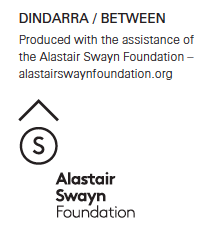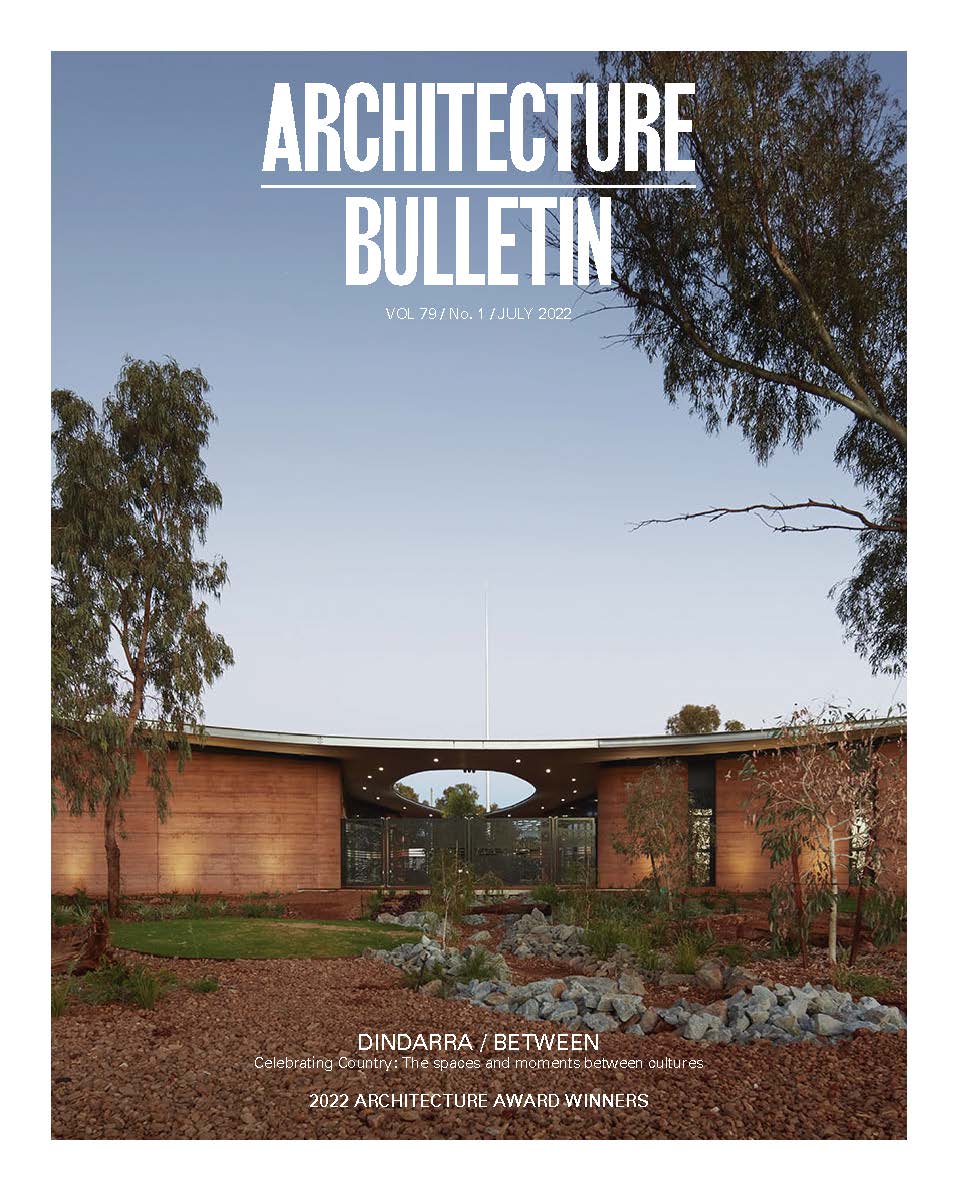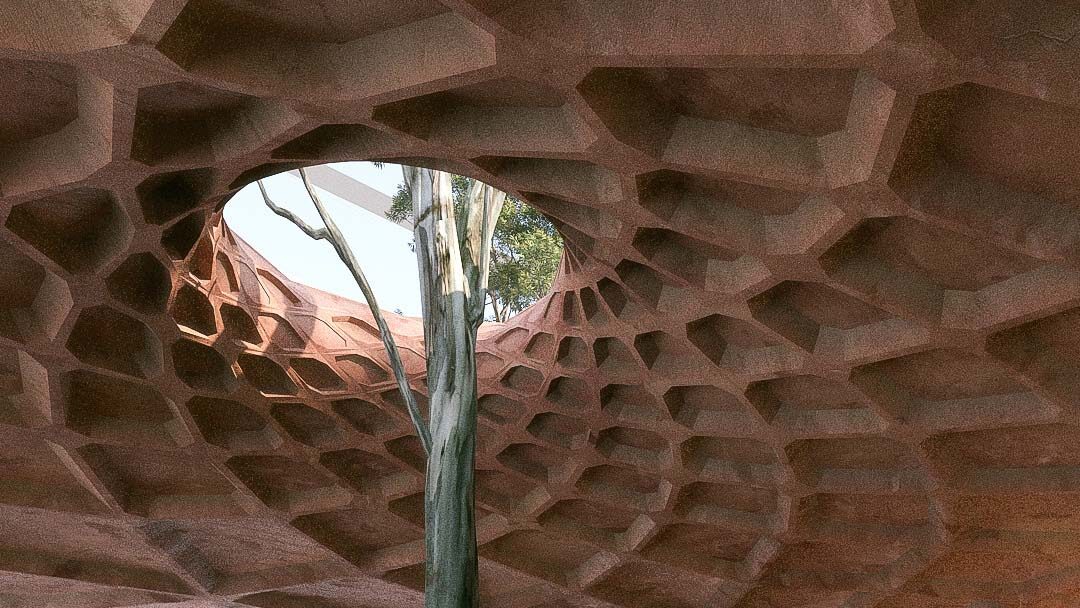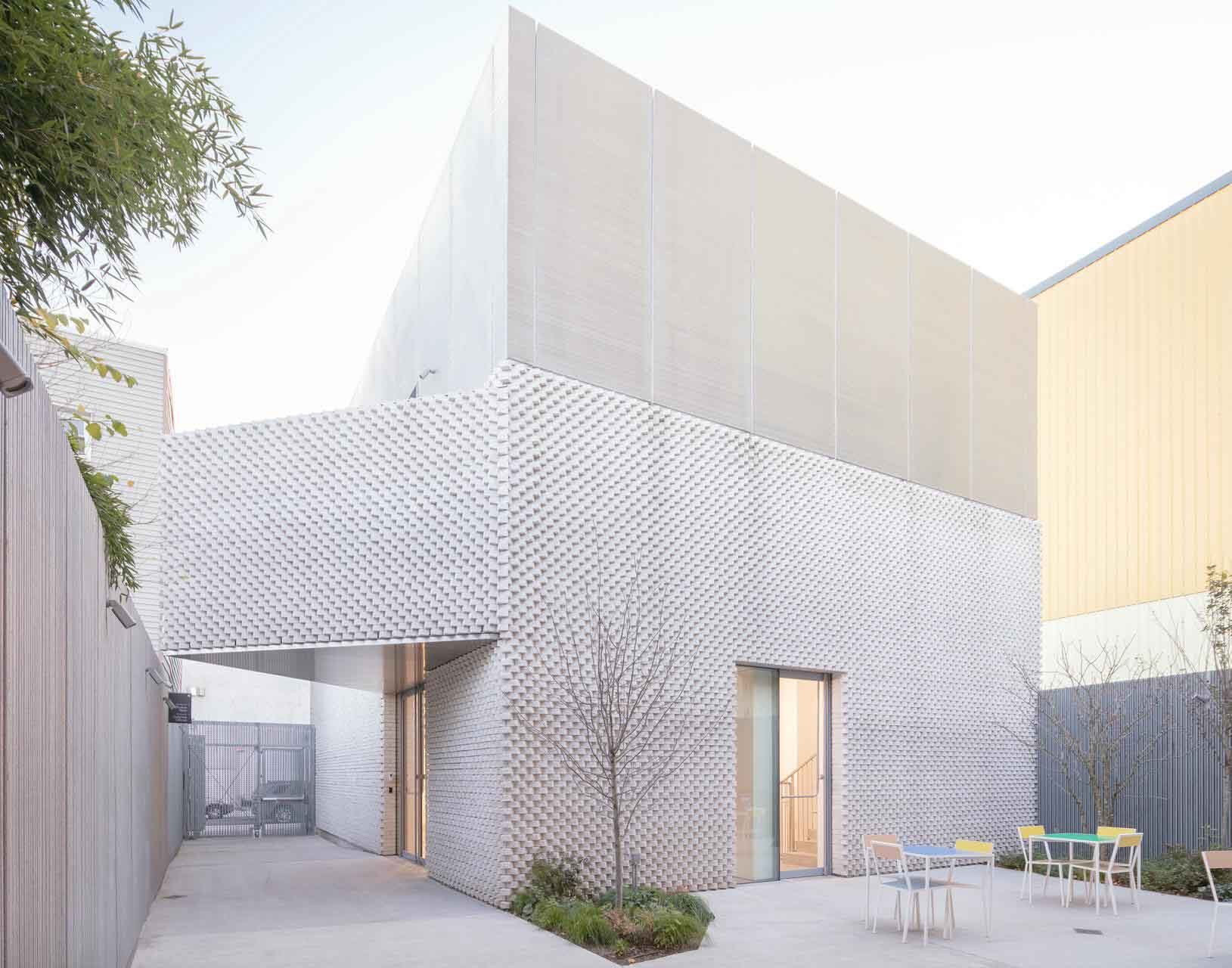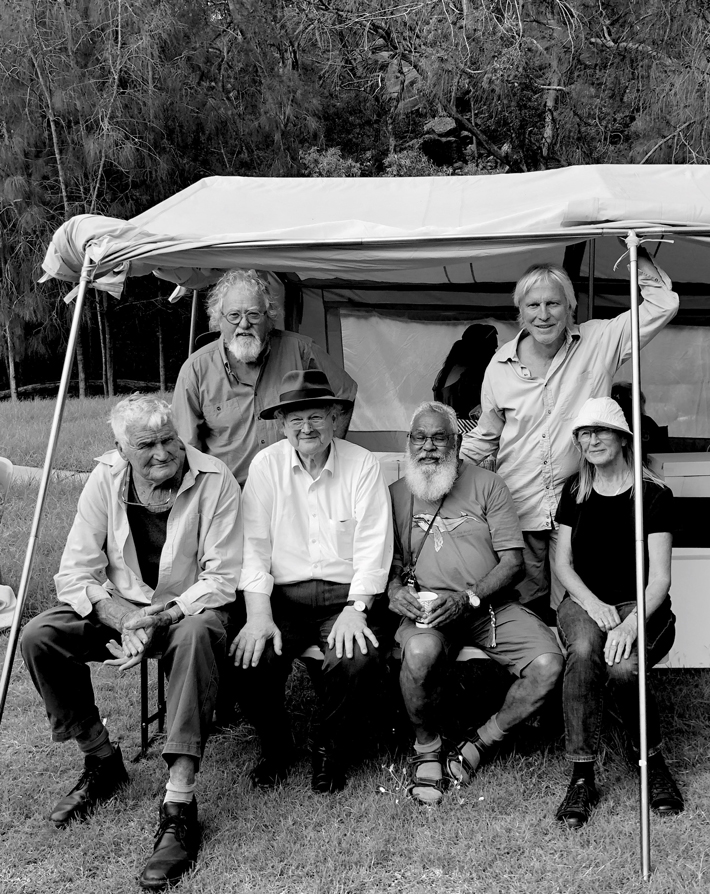
The passing of Uncle Max Dulumunmum Harrison was a great blow to Australia’s living knowledge. Australian architecture had the privilege for almost 20 years to learn from his teachings, through ritual and story. The breadth of knowledge covered over this time is hard to tell in just a few stories, yet, stories have power. Power to transcend time, culture and prejudice. This is what Uncle Max showed to us. Uncle Max’s stories came from deep knowledge that intertwined culture, nature, history, perception and wisdom in a way that our siloed Western thinking struggles to do.
Uncle Max guided us to see the country’s greatest library. It is now up to us to slow down, see, listen and take the time to consider and trust its teachings. The following stories were collated with permission from Uncle Max’s family and through the generous support of some of Australian architecture’s elders.
“‘I’ve got to give it away to keep it” – Uncle Max Dulumunmum Harrison.
Two Waterfalls
Words by RICHARD LEPLASTRIER AS TOLD TO OWEN KELLY
Uncle Max opened a symposium in Melbourne, as we travelled there together in a taxi from the airport I was thinking about how cities start. I knew a bit about Melbourne, I grew up there and I knew it was at the north end of this enormous bay. They put the city at the north end of the bay where the Yarra River ran out through its delta. That’s where the south westerly from the roaring forties comes in … not such smart thinking. Perhaps Geelong is where it should have been.
This bay is almost 70 kilometres across. You can see the You Yangs on the horizon in the west from the east side but you can’t see one shore of the bay to the other. Perhaps the heart of Melbourne is not Melbourne itself, it is Nairm (or Narrm / Port Phillip Bay).
In the back of the taxi I am thinking about Melbourne and I asked Uncle Max, “what do you know about Melbourne?”
“Two waterfalls. The first waterfall is up the Yarra (Birrarrung)1, you white fellas came there, rowed up the Yarra, came to a point where there was a whole pile of rocks crossing over with the water pouring over and you couldn’t row any further so you stuck your flag somewhere there … William Street?”2
“What happened to that waterfall?”
“You fellas blew it up”
“Ahh … right … and the second?”
“The second is the real one, you know where Nairm opens up into Bass Strait? There’s a lot of water goes out of Nairm. From high tide to low tide a 900 rise and fall.”
You can imagine how much water goes out that narrow neck (the Rip) between Port Lonsdale and the Nepean Peninsular. It’s probably the most dangerous point along the coast.
“What about the waterfall?”
“Before the sea levels rose, which was about 10,000 years ago3, Nairm was a big plain, probably quite moist as there is a lot of water that comes into it from the surrounding areas, but the sea levels were 200-300 feet lower than where they are now. There were rivers and they all went out to the pinch point at Port Lonsdale there, and there was a great cliff face there and the water went over the cliff and down, because the sea level was way below. And as the sea levels came up over time so the waterfall is still there but it is all underwater. The water is still ripping out there and the turbulence where it drops off is phenomenal.”
That’s where ships and lives are lost, ships have to be piloted out of there because it’s so dangerous. if you go back to the records from 15 years ago, a pilot vessel that was un-sinkable and un-capsizeable was lost there with all lives.
Uncle Max was able to go back millennia. He is not from that area, he is a Yuin man but has carried that knowledge from stories and songs. Deep knowledge.
That’s the sort of knowledge that the First Australians are willing to share with us through the Makarrata and the Uluru Statement from the Heart and we haven’t even answered them.You couldn’t be less grateful than that.
NOTES
1 https://cv.vic.gov.au/stories/aboriginal-culture/nyernila/boon-wurrung-the-filling-of-the-bay-the-time-of-chaos/
2 https://poi-australia.com.au/points-of-interest/australia/victoria/melbourne/the-site-of-the-falls-william-st-melbourne-vic/
3 https://drive.google.com/file/d/1E3yU3yIoRHmS5hkYd5nLOiHPdLC9oy7n/view
WORDS by PETER STUTCHBURY
Uncle Max Dulumunmun Harrison, a Yuin Elder. Taught traditionally by three uncles from the age of 9 to 16. On one of our travels we crossed the Bega bridge on route to a site at Mallacoota. Uncle told me the stories of their camps on their river signalling to the location as we passed.
It sounded wonderful until he added the context of camps being “moved on” by police and children taken for “repatriation”.
I felt so ashamed, my father’s mate had a beef farm north of Bega, we’d regularly cross that bridge 60 years ago and frowned down at the “campers” – fancy one of those very campers having the grace not to judge but to educate.
Uncle Max represented the best of human values. He led by example and taught with elemental, accurate, humble, and educated language. His life was a composition of tradition, woven purposefully into the foreign culture placed upon this land. By retaining the “life” of traditional values he sought to improve the life of those who listened. A generosity. What he knew had been developed over tens of thousands of years, he was a conduit, a translator, a guide. It was always a pleasure to be alongside and a gift to slowly develop an understanding – his mantra was simple “respect nature”.
I recall when he smoked our freshly finished home five years ago. Friends had come to experience. He could feel energies. The special fungi was lit and smoke danced into the rooms, –he recited, and repeated a language blessingthen moved purposefully around the home someplaces given more attention than others – reason–we followed, we slipped back to simpler times,to ancient times to connected times when theydidn’t take all the eggs, just what they needed.Otherwise, no chicks, no new eggs.
The old fella stood on a rock ledge at Riversdale and was explaining the winds to students, he was asked could he call up a wind. “Do you need one?” was the answer. But as he left that ledge he looked west and talked to Koorah koo-rie the big wind – a little later on a still warm day for ten minutes the wind blew then stopped.
Many of us have a fascination with nature, Uncle was nature. He could see the connections, feel the life forces understand the indicators – it was like he was reading a book.
Over time I learnt to trust his perceptions, guidance and eldership, his wisdom.
We first met over two decades ago he had seen Israel House and asked if he could meet the architect. We met by a fire on a rock ledge overlooking the house six weeks later. He was dressed in his flannel shirt walking shorts and runners he heard me coming and didn’t move, as I asked to sit he looked up and introduced himself, “Hi I’m Max, I like the house.” We talked. He asked “Did you hear the men singing?” I replied “what men?” Pointing to a small grove of trees he said, “men’s ceremony, you’ve respected men’s ceremony.” I withdrew a little and felt I had to explain the site for the house was simply a feeling and that the previously chosen site was wrong, where we chose was respectful to the land – “and the ancients” he explained.
A powerful introduction, a foreign yet easily imagined world – how could this be? From then on Uncle became an educator and friend in our tribe also permitting us to walk with his tribe. Impossible to cover in words that inclusion.
In mid 2021 I was visiting Ken (Israel House) it was dark, no moon, and the descent to the house is through a variety of bush pathways – the sound of rigging rattling against masts in Pittwater and the timeless mood of the West Head peninsula silhouetted against a deep cobalt blue sky across the bay. Fifteen seconds before I reached the plank that crosses to the dimly lit tiny vertical house, resting against the rock ledge I heard men softly singing, I turned then I remembered.
Wisdom of the Elders
WORDS: LINDSAY JOHNSTON / EDITED FROM AN ESSAY IN AREA107, MILAN 2009
“Mother Earth births
everything for us. Father
Sky carries the water
and oxygen for us to breathe.
Grandfather Sun warms
the planet, warms our body,
gives us light so we can see,
raises the food that the
Mother births and raises
most of our relations,
all our plants and trees.
Grandmother Moon moves
the water and gives us the
woman-time and our birthing”
Uncle Max Dulumunmun Harrison and Peter McConchie (2009), My People’s Dreaming, Finch Publishing, Sydney
We stood on the grass under the trees in the Botanic Gardens of Sydney, the traditional land of the Gadigal people with Glenn Murcutt, Aboriginal Elder Uncle Max Dulumunmun Harrison, Peter Stutchbury and a gathering of people for the launch of Uncle Max’s book My People’s Dreaming – an Aboriginal Elder speaks on life, land, spirit and forgiveness. The event took place with glimpses of Utzon’s Opera House through the treetops and with the tall buildings of Harry Seidler, Renzo Piano and many others looking down on us from the city centre across Macquarie Street. Richard Leplastrier was there with us as well, in spirit, although he was in Japan on his way to Denmark. Glenn, Uncle Max, Peter and Richard, with Professor Brit Andresen from Norway and Queensland, have become a close family, privileged with each other’s company and engaged in, one could say, spreading a teaching of thought and action that is commonly rooted in the accumulated wisdom of these two great men, Glenn and Max, now our Elders.
Glenn speaks often botanically, as he did in his Pritzker Prize acceptance speech, his knowledge and observation of the natural environment is extraordinary. To walk over a landscape with Glenn and to hear him identify and discuss the plant species with their botanical names, is to have revealed insights into geology, rainfall, water flow, wind direction, solar access, bushfire threats, the movements of the seasons, wildlife, scents. So, it is that his buildings are, first, grounded on the reading of the land, of the landscape. Walking with Uncle Max over this same ground is another, parallel and complementary journey. He will speak of the hillside and the trees as his family relations, of the traditions and journeys of his ancestors, of reading the land, of spirit lines, of totems, of sacred places and of the landscape as a source of food.
One of Uncle Max Dulumunmun’s penetrating sayings is “To keep it, we must give it away”, referring to the need for the Elders to reveal their knowledge and culture to younger generations, to be generous
WORDS by BRIT ANDRESEN
In the winter we would all gather at Riversdale for the Glenn Murcutt International Master Class to participate in the annual building design with landscape studio.
Some would arrive from places as far away as Africa, Asia, or Europe or the Americas and others from distant territories around Australia. Each of us would arrive with personal memories of our childhood landscapes and sensual experiences of nature. From architectural practice we’d bring abstract concepts about sites and location and from myths and legends of our exotic societies. We’d all carry with us culturally embedded ideas about the land and the natural world. And while everyone was from a landscape elsewhere; Uncle Max Dulumunmun Harrison, Yuin Elder, was from this place, his Country, the south-east coast of NSW.
On the first day of the studio since 2005 Uncle Max would come to welcome everyone to his Country and invite us to join a smoking-in ceremony. A small fire would be lit on the hillside with views to the mountain and the river. Securing his red headband, he’d take hold of a branch of green leaves, and he’d pause to ask permission from the bush before snapping the stalk for the fire to create a plume of smoke. Uncle Max would tell us about Yuin cosmology, of grandfather sun, grandmother moon, father sky and mother earth and insert his personal teachings in conversation and add in a brainteaser, such as ‘I’ve got to give it away to keep it”.
On walkabout along the ridge, he’d reveal what we couldn’t easily see: reaching for a leaf or taking sap from a tree he’d demonstrate that the bush is both a supermarket and a pharmacy, he’d point out signs and areas vulnerable to landslip or prone to destructive wind and fire, then, he’d take us on a side track to feel the humidity increase on the southeast slope where the ferns thrive and finally on to the lookout where the rock orchids grow. These walks with Uncle Max also revealed that knowledge of Country comes from a dimension, beyond personal experience and ecology, a dimension where everything of the land is understood as integral with the spirituality of the culture.
It is with great sadness that we are not gathering at Riversdale this year with Uncle Max who died in December 2021 aged 85 but we can continue to reflect on his teaching and the focus of his three truths: “See the land…the beauty; Hear the land…the story; Feel the land…the spirit.”
Owen Kelly and Bobbie Bayley studied architecture at Newcastle, where they were lucky enough to learn from some incredible teachers including Uncle Max. Their Grand Section journey by bicycle across Australia allowed them to realise the power of these teachings. They work with Healthabitat and in residential architecture.
